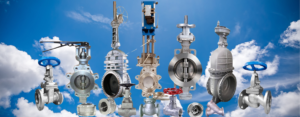
Check valves are frequently neglected and misunderstood components in water flow systems, yet their correct size and type are crucial for optimal functionality. These valves allow one-way flow while preventing backflow. Choosing an improperly sized or incorrect valve can lead to significant hydrodynamic challenges, impacting the performance of pumping systems and risking failure. To ensure the right check valve is selected, a thorough analysis of the system’s hydrodynamics is essential from the outset. Adopting a “system approach” is crucial when determining the valve’s size and type, recognizing that the hydraulic conditions of each system are unique.
Factors to Consider in Selecting Check Valve for Wastewater Application
- What is the system’s flow rate or anticipated flow rate (GPM)?
- What are the pressures (PSI or FEET) under static and pumping conditions?
- What is the pipeline diameter size?
- What type of medium is it (potable water, wastewater, slurries, etc.)?
- What chemicals might be employed in the system?
- What size solids, if any, will the system handle?
- Is it a multiple-pump application?
- Is it a header system?
- What is the location and length (in feet) of the discharge pipeline?
- Open or closed discharge line?
How will water flow directly affect check valve size and type? Water flow through a system directly impacts check valve size and type selection. Check valves permit one-way fluid flow while preventing backflow. The size and type of check valve needed depend on factors such as the flow rate, pressure, and fluid characteristics. The correct sizing ensures optimal performance, preventing issues like water hammer (sudden pressure surge) and ensuring efficient operation. Understanding and matching the flow dynamics of the water system is crucial in selecting the appropriate check valve size and type for effective and reliable operation.
What media is used? What is the type of water? The size of solids passing through will dictate the size and style needed to handle the debris. If you’re running grey water or regular sewage, you should specify a full port check valve to allow particles and stringy material to pass readily while preventing the swing check valve’s hinge arm from becoming caught.
What are the internal components? Such as seat trim, may also differ based on the specifics of each system and application. Another essential factor to know is where the valve will be located. Is it outdoors in a coastal environment? If you have salty air, you want to make sure you have stainless steel components.
Where and How far the pipeline is going? It is the data required to compute head pressure and surge potentials. It is critical to understand whether the water or wastewater flow will be open discharge in a gravity system or pressurized closed in a pressurized closed system. Each variable impacts the calculations and may require different valve types with an externally assisted closing system.
What is your flow rate and pipe size? This is particularly important. Certain check valves have certain velocity ranges and specific acceptable head parameters. If they are not properly proportioned, the system will have maintenance concerns.
With increased flow velocity, surge potential increases if a pump fails. If something goes wrong, you may experience increased slamming potential or water hammer. Surges will flow down the pipeline, demonstrating yet again why it is critical to consider the system as a whole and how an incorrectly sized valve can have an impact on more than just the area or pipe where it is placed.
Too low velocity can result in the chattering of the internals, depending on the style of the valve, causing the spring or closing mechanism inside the valve to wear away at a faster-than-normal rate. The valve may barely open under low-flow conditions, which will eat away the seating components, leading to a shorter lifespan.
You can wear that valve out if you’re too low or too high.
Check valves with additional features provide operators with greater control and monitoring of the valve’s operation. Add-ons like a position indicator visually indicate the internal disc’s location during operation and shutdown. A backflow device is another option to explore. These devices can be installed in check valves and manually operated when backflow, pump priming, line draining, or system tests are required. Limit switches are also extremely useful for remote indication of valve position and a positive flow sign.

Conclusion
Finally, choosing the correct check valve for wastewater applications is a vital step in guaranteeing a system’s efficiency and lifespan. As we’ve explored, various factors include flow dynamics, pressure conditions, and wastewater characteristics. Whether dealing with sewage systems, industrial wastewater treatment, or storm water management, the check valve is vital to prevent backflow, contamination, and potential damage. To identify the suitable check valve size and type, it is critical to carefully examine the specific requirements of the wastewater system. Factors like flow rates, the presence of solids, and the potential for water hammer effects should all be considered. By investing the time and effort to choose the right check valve tailored to the unique demands of the wastewater application, operators can enhance reliability, reduce maintenance costs, and contribute to the overall effectiveness of wastewater management systems. Finally, an appropriate check valve is critical in maintaining continuous and smooth wastewater flow in a variety of industrial and municipal applications.






